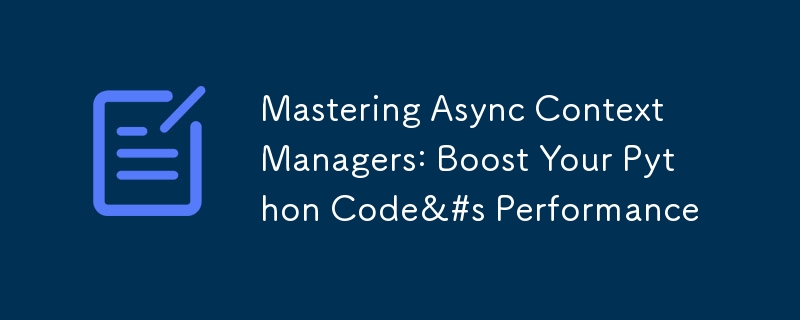Mastering Async Context Managers: Boost Your Python Code&#s Performance
来源:dev.to
时间:2024-12-11 11:15:54 290浏览 收藏
本篇文章主要是结合我之前面试的各种经历和实战开发中遇到的问题解决经验整理的,希望这篇《Mastering Async Context Managers: Boost Your Python Codes Performance》对你有很大帮助!欢迎收藏,分享给更多的需要的朋友学习~

python 中的异步上下文管理器是处理并发应用程序中资源的游戏规则改变者。它们就像常规的上下文管理器,但有一点不同 - 它们可以与异步代码无缝协作。
让我们从基础开始。要创建异步上下文管理器,我们需要实现两个特殊方法:__aenter__ 和 __aexit__。这些是我们在常规上下文管理器中使用的 __enter__ 和 __exit__ 的异步版本。
这是一个简单的例子:
class asyncresource:
async def __aenter__(self):
print("acquiring resource")
await asyncio.sleep(1) # simulating async acquisition
return self
async def __aexit__(self, exc_type, exc_value, traceback):
print("releasing resource")
await asyncio.sleep(1) # simulating async release
async def main():
async with asyncresource() as resource:
print("using resource")
asyncio.run(main())
在此示例中,我们模拟资源的异步获取和释放。 async with 语句负责在正确的时间调用 __aenter__ 和 __aexit__。
现在,我们来谈谈为什么异步上下文管理器如此有用。它们非常适合以非阻塞方式管理需要异步操作的资源,例如数据库连接、网络套接字或文件处理程序。
以数据库连接为例。我们可以创建一个管理连接池的异步上下文管理器:
import asyncpg
class databasepool:
def __init__(self, dsn):
self.dsn = dsn
self.pool = none
async def __aenter__(self):
self.pool = await asyncpg.create_pool(self.dsn)
return self.pool
async def __aexit__(self, exc_type, exc_value, traceback):
await self.pool.close()
async def main():
async with databasepool('postgresql://user:password@localhost/db') as pool:
async with pool.acquire() as conn:
result = await conn.fetch('select * from users')
print(result)
asyncio.run(main())
此设置可确保我们有效地管理数据库连接。池在我们进入上下文时创建,并在我们退出时正确关闭。
异步上下文管理器中的错误处理与常规错误处理类似。如果上下文中发生错误,则 __aexit__ 方法会接收异常信息。我们可以处理这些错误或让它们传播:
class errorhandlingresource:
async def __aenter__(self):
return self
async def __aexit__(self, exc_type, exc_value, traceback):
if exc_type is valueerror:
print("caught valueerror, suppressing")
return true # suppress the exception
return false # let other exceptions propagate
async def main():
async with errorhandlingresource():
raise valueerror("oops!")
print("this will be printed")
async with errorhandlingresource():
raise runtimeerror("unhandled!")
print("this won't be printed")
asyncio.run(main())
在此示例中,我们抑制 valueerror 但允许其他异常传播。
异步上下文管理器也非常适合实现分布式锁。这是一个使用 redis 的简单示例:
import aioredis
class distributedlock:
def __init__(self, redis, lock_name, expire=10):
self.redis = redis
self.lock_name = lock_name
self.expire = expire
async def __aenter__(self):
while true:
locked = await self.redis.set(self.lock_name, "1", expire=self.expire, nx=true)
if locked:
return self
await asyncio.sleep(0.1)
async def __aexit__(self, exc_type, exc_value, traceback):
await self.redis.delete(self.lock_name)
async def main():
redis = await aioredis.create_redis_pool('redis://localhost')
async with distributedlock(redis, "my_lock"):
print("critical section")
await redis.close()
asyncio.run(main())
此锁确保一次只有一个进程可以执行关键部分,即使跨多台机器也是如此。
我们还可以将异步上下文管理器用于事务范围:
class asynctransaction:
def __init__(self, conn):
self.conn = conn
async def __aenter__(self):
await self.conn.execute('begin')
return self
async def __aexit__(self, exc_type, exc_value, traceback):
if exc_type is none:
await self.conn.execute('commit')
else:
await self.conn.execute('rollback')
async def transfer_funds(from_account, to_account, amount):
async with asynctransaction(conn):
await conn.execute('update accounts set balance = balance - $1 where id = $2', amount, from_account)
await conn.execute('update accounts set balance = balance + $1 where id = $2', amount, to_account)
此设置可确保我们的数据库事务始终正确提交或回滚,即使面对异常也是如此。
异步上下文管理器可以与其他异步原语结合使用,以获得更强大的模式。例如,我们可以将它们与 asyncio.gather 一起使用来进行并行资源管理:
async def process_data(data):
async with ResourceManager() as rm:
results = await asyncio.gather(
rm.process(data[0]),
rm.process(data[1]),
rm.process(data[2])
)
return results
这使我们能够并行处理多个数据,同时仍然确保适当的资源管理。
总之,异步上下文管理器是管理异步 python 代码中资源的强大工具。它们提供了一种干净、直观的方式来处理异步设置和拆卸、错误处理和资源清理。通过掌握异步上下文管理器,您将能够构建强大的、可扩展的 python 应用程序,这些应用程序可以轻松处理复杂的并发工作流程。
我们的创作
一定要看看我们的创作:
投资者中心 | 智能生活 | 时代与回响 | 令人费解的谜团 | 印度教 | 精英开发 | js学校
我们在媒体上
科技考拉洞察 | 时代与回响世界 | 投资者中央媒体 | 令人费解的谜团 | 科学与时代媒介 | 现代印度教
以上就是《Mastering Async Context Managers: Boost Your Python Codes Performance》的详细内容,更多关于的资料请关注golang学习网公众号!
-
501 收藏
-
501 收藏
-
501 收藏
-
501 收藏
-
501 收藏
-
334 收藏
-
372 收藏
-
416 收藏
-
193 收藏
-
178 收藏
-
231 收藏
-
268 收藏
-
499 收藏
-
421 收藏
-
349 收藏
-
208 收藏
-
166 收藏
-

- 前端进阶之JavaScript设计模式
- 设计模式是开发人员在软件开发过程中面临一般问题时的解决方案,代表了最佳的实践。本课程的主打内容包括JS常见设计模式以及具体应用场景,打造一站式知识长龙服务,适合有JS基础的同学学习。
- 立即学习 543次学习
-

- GO语言核心编程课程
- 本课程采用真实案例,全面具体可落地,从理论到实践,一步一步将GO核心编程技术、编程思想、底层实现融会贯通,使学习者贴近时代脉搏,做IT互联网时代的弄潮儿。
- 立即学习 516次学习
-

- 简单聊聊mysql8与网络通信
- 如有问题加微信:Le-studyg;在课程中,我们将首先介绍MySQL8的新特性,包括性能优化、安全增强、新数据类型等,帮助学生快速熟悉MySQL8的最新功能。接着,我们将深入解析MySQL的网络通信机制,包括协议、连接管理、数据传输等,让
- 立即学习 500次学习
-

- JavaScript正则表达式基础与实战
- 在任何一门编程语言中,正则表达式,都是一项重要的知识,它提供了高效的字符串匹配与捕获机制,可以极大的简化程序设计。
- 立即学习 487次学习
-

- 从零制作响应式网站—Grid布局
- 本系列教程将展示从零制作一个假想的网络科技公司官网,分为导航,轮播,关于我们,成功案例,服务流程,团队介绍,数据部分,公司动态,底部信息等内容区块。网站整体采用CSSGrid布局,支持响应式,有流畅过渡和展现动画。
- 立即学习 485次学习
